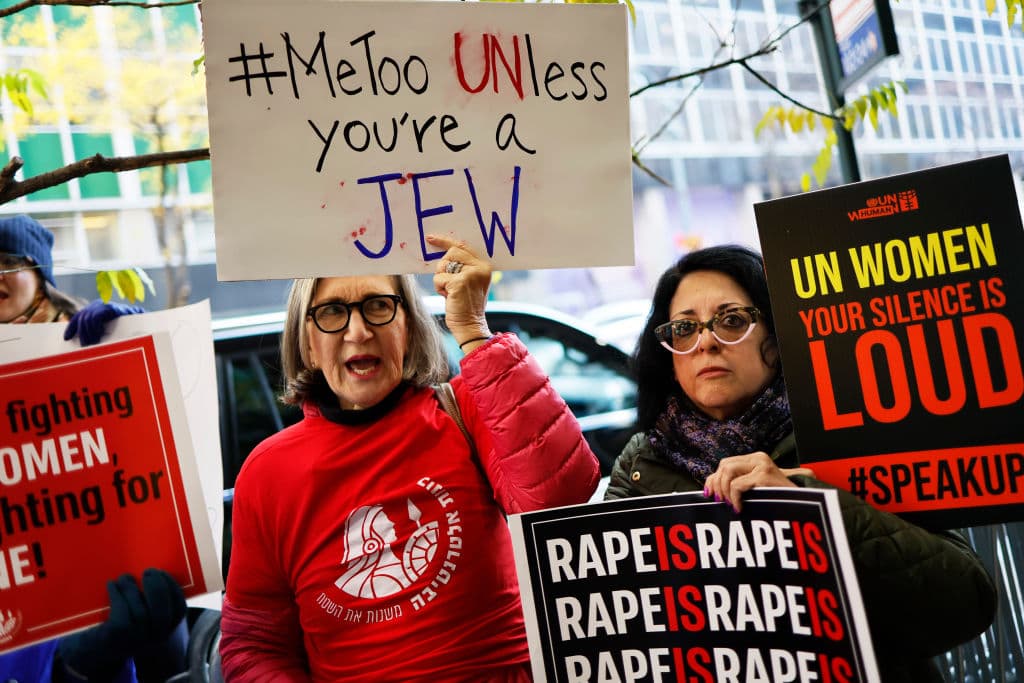Hear Our Voices: Jewish Women Bear Witness to the Atrocities Committed by Hamas Against Women
‘In the face of terror, we cannot be quiet,’ Sheryl Sandberg tells a gathering of 800 women at the United Nations.

“Silence is complicity. And in the face of terror we cannot be quiet.” Sheryl Sandberg opened her speech Monday before a packed room at the United Nations, after weeks of silence from women’s organizations and leaders, as well as the UN itself, unable to specifically condemn Hamas for its barbarism, rape, mutilation and murder of women.
The reason for the silence is because the victims were Jews. This realization, which has grown since October 7, was echoed by hundreds of women who convened earlier that morning, outside the United Nations for a rally, chanting “Me too, unless you are a Jew.”
A row of women standing behind the speakers wore nude costumes, painted with blood around their underwear and down their legs, some with tape across their mouths, to symbolically represent their murdered, raped, and mutilated sisters in Israel.
The double standard around rape and gender based war crimes, especially amongst liberal women’s and human rights organizations has sent another blast of shock and pain through the Jewish community on top of the trauma of the massacre itself.
The chief executive of the National Council of Jewish Women, Sheila Katz, explained, “The idea that rape is sometimes okay, that some women have more dignity than others, is more than hypocrisy, it is a betrayal of all women, because when our agency and full humanness can be traded away, none of us are safe.”
A little later that day, Ms. Sandberg, who was a lead host of the event was joined on the stage inside the United Nations, by her co-host, the Israeli Ambassador to the United Nations, Gilad Erdan; Senator Gillibrand; Secretary Clinton; activist Mandana Dayani; and first responders and eyewitnesses of the atrocities of October 7.
“The atrocities committed by Hamas were more barbaric than ISIS… (and some may say) more cruel and barbaric than the Nazis,” Mr. Erdan said, framing what the audience was about to hear. Yet with all the videos captured from the cell phones of the victims, survivors, or by the Hamas perpetrators themselves, many have refused to believe — or have even justified the attacks.
Mr. Erdan explained that these violent acts towards women were not spontaneous acts, but premeditated violence to achieve maximum psychological fear, not just in victims or witnesses, but in Jews around the world. Ms. Gillibrand expressed this fear, her voice full of empathy, breaking up with emotion, “I can’t imagine what it’s like to be a Jewish family today, anywhere in the globe.”
One of the first to arrive on the site of the massacre, Simcha Greinman, described things he confronted on October 7 through his volunteering with a non-governmental rescue and recovery organization in Israel, ZAKA, whose primary task is to rescue what is left of a body after an attack for proper burial.
“Horrific things, I saw with my own eyes, and I dealt with my own hands… I walked into a house and saw in front of my eyes a woman, lying, she was naked.” He paused, then, “She had nails and different—” his voice stopped suddenly, as he struggled to speak the unimaginable. After a long pause, “she had nails and different objects in her female organs.”
Hamas’ sadism did not stop with their victim’s last heartbeat. Mr. Greinman found another woman leaning on her bed, naked from the waist down, shot from behind. “When we turned her around, she had an open grenade in her hand.” Another first responder, Shari Mendez, serves in a unit of the army that follows procedures required after the death of a female soldier, something that has become necessary as more women are allowed into combat units.
On October 8 she showed up at the Shura Base, where the victims of the Hamas massacre were brought. She described her twofold shock — first at the sheer number of body bags and different sizes of the bags and the condition of the body bags, “many oozing liquid”; second, at the extent of Hamas’ cruelty.
“It was,” she said, “important to us and our teams, groups of women, that we show them deep love and gentleness as we prepared them for burial… It was a room for women taking care of other women. We knew we’d likely be the last people to see these young women and we held them in our hearts, even just for a moment as if they were our daughters, and really loved them.”
Ms. Sandberg laid it out plainly: “The world has to decide whom to believe. Do we believe the Hamas spokesperson who said rape is forbidden therefore it couldn’t possibly happened on October 7, or do we believe the women, whose bodies tell us how they spent the last minutes of their lives?”
At the end of the hour, many with eyes still tearful, the hundreds of women walked back through the history-laden hallways of the United Nations, each floor displaying different memorials and exhibits on peace and security, humanitarian action, and sustainability. I passed an exhibit on the Nakba, titled “Palestine: A Land With a People,” and wondered:
What are the chances I might one day find in this building that was once a temple of idealism, an exhibit on the October 7 Massacre of Hamas? I thought about Ms. Sandberg’s last line: “If we cannot agree that rape is wrong, then we have accepted the unacceptable. Then the question will be not what is happening in the Middle East, but what is happening to our humanity?”

